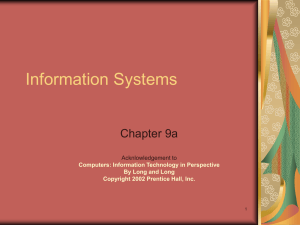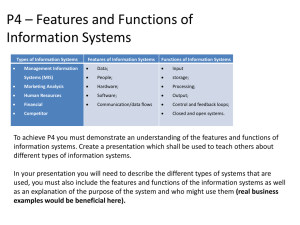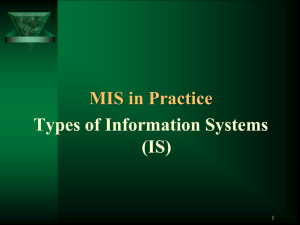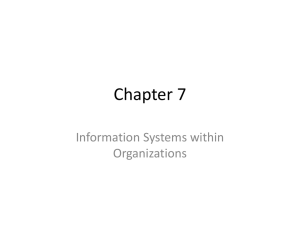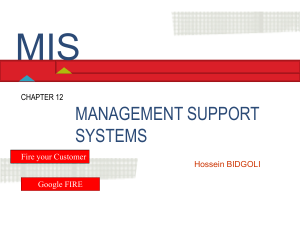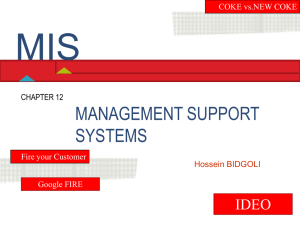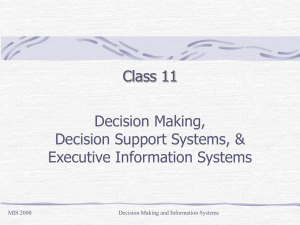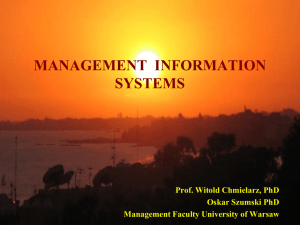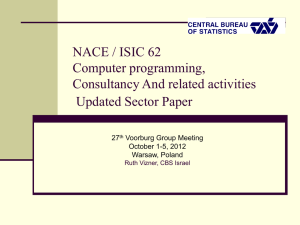MANAGEMENT INFORMATION SYSTEMS
advertisement
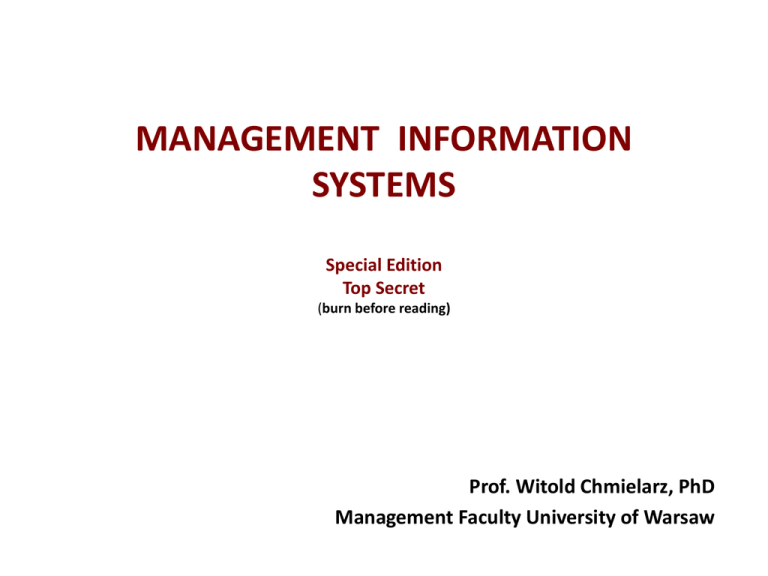
MANAGEMENT INFORMATION SYSTEMS Special Edition Top Secret (burn before reading) Prof. Witold Chmielarz, PhD Management Faculty University of Warsaw Tools for Management Information Systems • • • • • • • • • Transaction Processing Systems (TPS) 1965 Management Information Systems (MIS) 1970 Decision Support Systems (DSS) 1975-78 Expert Systems (ES) 1980 Executive Information Systems &Executive Support Systems – 1980+ Artificial Intelligence (Artificial Neural Networks) 1985 (?) (ES II generation, Knowledge Based IS, Business Intelligence Systems) 1995, 2000 Integrated Management Support Systems 1990+ Transformed into Digital Economy Systems 2000+ Digital economy systems (1991+) 2 TRANSACTION SYSTEMS PROCESSING (TSP) • Data processing – manipulation or transformation numbers and letters for the purpose of increasing their usefulness (data gathering, data manipulation – classifying, sorting, selecting etc). • TSP, D(data) PS or A(analytic)IS – the first single simple systems made mainly for gathering and processing data not for decision making, operating separately in the frames of the firm; in the beginning often without common data-base 3 MIS – Management Information Systems Definition: • MIS - as a computer-based system that makes information available to users with similar needs • MIS - is designed to provide past, present and future routine information appropriate for planning, organizing the operations of a functional area in an organization The information describes the firm or one of its major system in terms of what has happened in the past and is happening now (sometimes in the future) • MIS support functional managers by providing them with periodic reports that include some summaries, comparisons and other statistics Consists of: user interface, database, database system management and set of applications 4 The main elements of MIS • A database – is a collectionof files serving as a data resource for computer based information systems (MIS), • A batabase management system (DBMS) is a software program (or group of programs) that managesand provides access to a database • Data warehouse – is a repository of historical data (millions of records), subject oriented and organized, integrated from various sources, that can easily be accessed and manipulated for decision support for example by: data mining – process of searching for unknown informationor relationships in large databases using tools as neural computing or case-based reasoning. • An application program – a set of computer instructions written in a programming language, the purpose of which is to provide functionality to a user… 5 Decision Support Systems - definitions • …Decision Support Systems couple the intellectual resources of individuals with the capabilities of the computer to improve the quality of decisions… • …It is a computer based support system for management decision makers who deal with semistructural problems… • …It is a comptuer based information system that combines models and data in an attempt to solve semistructured problems with extensive user involvment… Turban E. and R. Spraque W. Chmielarz: Faculty of Management University of Warsaw 6 Components of DSS 1. Data Management – includes the database, which contains relevant data for the situation and is managed by software called database management system (DBMS) 2. Model Management – includes financial, statistical, management science or other models that provide the system’s analytical capabilities and an appropriate software management 3. Communication Subsystem - the user can communicate with and command the DSS through this subsystem. It provides the user interface 4. Procedure management. This optional subsystem can support any of the other subsystem, mainly Model Management W. Chmielarz: Faculty of Management University of Warsaw 7 The Data Management Subsystem 1.DSS database (the same as MIS) 2.Database management system (see MIS) 3.Query facility The Database – collection of interrelated data organized in such a way that it corresponds to the needs and structure of an organization and can be used by more than one person for more than one application. Database Management System – is a software program to establish, update and use a model base; to screen each request for information and determine that the person making the request is indeed an autorised user. Administrator can obtain reports about that activity of users. An effective DBMS can provide support for many managerial activities, general navigation among records, support for a diverse set of data relationships, and report generation are typical examples. Query facility – provides the basis for access to data. It accepts request for data, determines how these request can be filled, formulates the detailed request, returns the results to user W. Chmielarz: Faculty of Management University of Warsaw 8 Model Management Subsystem 1. 2. 3. 4. 5. Model base Modelbase management system Model language Model directory Model execution, integration and command All of them are elements of: BI or KM systems Model base – contains routine, standard and special statistical, financial, managerial and other models that provide the analysis capabilities in the DSS. The ability to invoke, run, change, combine and inspect models. The models in the Model base can be divided into four main blocks: strategic, tactical, operational and basic (model buiding blocks and subroutines) Model base management – contains all tools for model management: modeling commands – creation, maintenance-update, database interface, modeling language Model language - special set of commands which can make possible to conctruct the model Model directory – catalog of all models in the system, whenever used Model execution, integration and command – rules of data management, dialog management and knowledge management W. Chmielarz: Faculty of Management University of Warsaw 9 Information Systems for top managers Two categories: • Executive Information Systems (EIS) – is a computer-based system that serves the information needs of top executives. Rapid access to timely information and direct access to management reports. Very user-friendly, supported by graphics, and provides exceptions reporting and drill-down capabilities (break down data for details: daily report corporate rates can be drilled down to find the daily sales in a region, or by product, or by salesperson. • Executive Support System (ESS) – is a comprehensive support system that goes beyond EIS to include communications, office automation, analysis support and intelligence issues resolving. There were somewere between a Final User and the other part of a DSS –additional tools for better decision making process. W. Chmielarz: Faculty of Management University of Warsaw 10 Expert systems – structure and components • Knowledge acquisition subsystem – accumulation, transfer and transformation (conversion) of problem solving expertise from some knowledge source to a computer program for constructing or expanding the knowledge base. Sources: human experts, textbooks, databases, special research reports and pictures. • Knowledge Base – contains knowledge necessary for understanding, formulate and solving problem.Consists of: facts - such as the problem situation and theory of the problem area and special rules that direct the use of knowledge to solve specific problems in a particular domain, W. Chmielarz: Faculty of Management University of Warsaw 11 Expert Systems – structure and components Inference Engine – brain of the ES, control structure or maybe the ruler interpreter; a computer program that provides a methodology for reasoning about information in the knowledge base and for formulating conclusions. It has three major elements: • An interpreter – (rule interpreter) – which executes chosen items, by applying the corresponding knowledge rules base, • A scheduler – which maintains control over the agenda. It estimates the effects of applying inference rules in light of item priorities or other criteria, • A consistency enforcer – which attempts to maintain a consistent representation of the emerging solution. W. Chmielarz: Faculty of Management University of Warsaw 12 Expert Systems – structure and components User Interface – expert system contain a language processor for friendly, problem-oriented communication between the user and the computer. Could be carried out in natural language or supplemented by menus or graphics • • • • Explanation Subsystem (Justifier) – can trace responsibility for conclusions: Why was a certain question asked by the expert system? How was a certain conclusion reached? Why was a certain alternative rejected? What is a plan to reach the solution? Knowledge Refining (Improving) System - can analyse their performance, learn from it and improve it for future consultations W. Chmielarz: Faculty of Management University of Warsaw 13 AIS – some benefits • Pattern recognition for character, speech and visual recognition • Systems that learn are more natural interfaces to the real world than systems that must be programmed • Hihg fault tolerance • Generalization – in work with noisy, incomplet or previously unsen input – generates reasonable response • Adaptivity – learns in new environment. In our XXI century AIS were divided into: • BIS – Business Information Systems, • APS – Automation of Production Systems (robots included) W. Chmielarz: Faculty of Management University of Warsaw 14 The BENEFITS RESULTING FROM LINKING – MIS & ES In this case Expert Systems supply: supervision and review of the process of registration, retrieval and execution of information processes, simplification of a correct base management for operators, optimization of questions and search paths as well as the amount of transfer data, intelligent-interfaces-like operation in commercial deposition structured databases. In such a kind of the architecture management information system (MIS) - provides information for ES as well as simplifies core data manipulation. 15 INTEGRATION ES & EIS • It seems that these two systems are seldom (only sometimes) linked in practice • EIS can return with questions to the ES in the hope of solving particular, specialist problems which they have and changes of obtaining appropriate solutions. • EIS can also refer to the knowledge base or procedures base of ES in situations when their user of interface is equipped with communication mechanism, which allows them such a function. • Now and again ES acts as a regular provider of reports (with a substantial grade) generated on the basis of data sent from EIS. 16 INTEGRATION BETWEEN SYSTEMS OF THE SAME TYPE This kind of linking applies mainly to: • ES - information exchange between systems from various categories or branches or • DSS - strengthening of the functions of humble (small, weak) systems through specialized transformation systems 17 Integrated Enterprise Information Systems development • • • Started in 1957 in the USA – when was established (APICS) American Production & lnventory Control Society - for …maintaining standards of computers application in production’ organizations management… APICS made assesments for the first standard MRP (Material Requirements Planning) in late 50. This standard let us compute accurate quantity of row materials (resources) adequately for flexible demand on commodities (assortment of products, articles) in time. The main goal of MRP: Inventory reduction (in warehouses and interoperational inventories), Accurate defining supply time of row materials and semi-finished articles supply Better usage of technical (production) infrastructure, Faster reaction under environmental changes, Control of individual stages of production. 1964 – Inventory Control System – the first information system with integrated functions of purchase, storage and distribution of commodities; in next years firstly created mainly for inwentory management in warehouses and for serial industrial production, particulary in electro-machinery branch, 18 Integrated Enterprise Information Systems development • 1989 APICS create new standard MRP II (Manufacturing Resource Planning commonly used in all great integrated information systems. • Standard MRP II was extended (in relation with the previous one) about elements connected with sale (retail and wholesale) and functions supported strategic production management • In 90. – all functions and processes were included in standard MRP II • Now it takes into account all spheres of management of the firm connected with preparation of production, production planning and management and sale or distribution production goods. • Besides of row materials - in MRP II there were human relations, financial flows, auxiliary materials etc. 19 Integrated Information Systems development • Mid-90 standard ERP (Enterprise Resource Planning – not approved) - Main purpose – complete integration of all levels of management of the company. • ERP included all proceses of production and distribution, which integrating various areas of firm activity, implementing critical – for success - information flows and let direct react for market changes. • Information updating - in real time and information for decision making process is accesable in that momment. • Additionally – procedures for simulationg variuos operations with possible analysis of their results (financial included). 20 Integrated Enterprise Information Systems development ERP areas: • Customer service – database about clients, orders processing, orders service, EDI – transfer of e-documents, internet access, • Production – wholesale servis, production costs calculating, purchasing materials rows, establishing time-table of production, forecasting of capabilities, calculating of critical level of inventories, process production control etc. • Finance – accounting, accounting documents flow control, preparing reports according to customer needs etc. • Logistic chain itegration - connection with next subsystems CRM (Customer Relationship Management), SCM (Supply Chain Management), VRM (Vendor Relationship Manegement) 21 ERP Diagram 22 INTEGRATED OFFICE PACKAGES In the functional range of such packages are programs like: • text editors - Microsoft Word, Writer. Word Pro, WordPerfect, • spreadsheets – Excel, Lotus, Calc • data bases – Access, • graphic presentation systems – PowerPoint, Harvard Graphics, • desk top publishing programs – Corel Ventura, Page Maker, Quark Xpress, • timetables – inside packages, WordPerfect Office, CaLANdar, • document libraries – ProShare, • electronic mail – Outlook Express, GroupWise, Outlook Express, • automatic document circulation – WorkMan, WordPerfect InForms, • specialist software serving office equipment – external faxes, scanners, modems, pagers, multimedia, voice and picture recognition – WinFax, OmniPage etc. 23 INTEGRATED OFFICE PACKAGES • • • • Additional characteristics of this software group are: a smaller function scale than MRPII/ERP: they are limited to office functions, homogeneous programs, also taking into consideration the offered functions as a method of communication with the user through various programming producers, cyclic development; the next step is assured - integration of package systems to the next - adding applications, accepting previous functions offered by the integrated programming created for small companies. 24 e-Commerce definitions • …Electronic Commerce (E-Commerce) is an artificial socio-economic structure, functioning based on widely used virtual nets, dynamic complexity and specific infrastructure. From this definition, it can be derived, that this structure cannot be directly transferred to the physical world, but some elements as payments and commodities originate from this world. In some areas of science, E-Commerce is defined as virtual commerce, although the prior is considerably wider as it includes processes such as telephone transactions… (B. Kubiak, Korowicki A. 1999) 25 e-Commerce definitions • ... To include only business transactions that deal with customers and suppliers, and it is often described in terms of the Internet, implying that there are no other communications alternatives ... (McLeod,...2001) • ... E-commerce – exchange the information across electronic networks, at any stage in the supply chain, whether within an organization, between businesses (B2B), between businesses and consumers (B2C), or between the public and private sector, whether paid or unpaid... (UK government), 26 e-Commerce definitions • ...An emerging concept that describes the process of buying and selling or exchanging of products, services, and information via computer networks including the Internet ... (Turban, at all 2000), • ... The sharing of business information, maintainin business relationships, and conducting business transactions by means of telecommunications networks (Zwass, 1998), • …E-business: • Use of digital technology and Internet to execute major business processes in the enterprise, • Includes e-commerce (electronic commerce): • Buying and selling of goods over Internet… (Laudon, 2010) W. Chmielarz: Faculty of Management University of Warsaw 27



